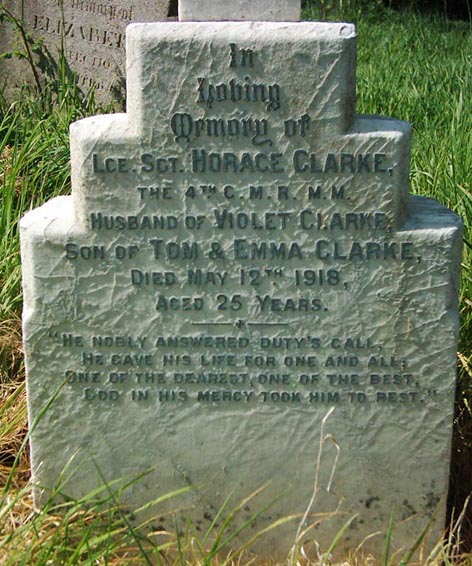136441 L/Sgt. Horace James Clarke, MM was born on February 1st, 1893, in the small village of Lidlington, in Bedfordshire, England. It is inferred from the lack of UK census returns for Horace, and indeed his parents, Tom and Emma Clarke, that the family must have emigrated to Canada some time before 1901.
Horace married Violet Ethel Gennings in York, Ontario, and the couple were living in Beach View Crescent, Toronto, when Horace, by then a carpenter by trade and who had seen no previous military service, answered the call in 1915.
Attesting as 136441, Private, into the 74th Bn, on November 9th, 1915, Horace arrived back in England, aboard the SS Empress of Britain on April 9th, 1916, and thence was sent straight on to France. On June 9th he was amongst 41 men of the 74th Bn who, after the 4th CMR's huge losses at the outset of the 'Battle for Mount Sorrel' (2nd June, 1916), were drafted in to rebuild the regiment on June 9th, 1916.
On November 7th, 1916, Horace was with No.2 Canadian Field Ambulance with influenza, but was subsequently appointed L/Cpl on December 18th. On March 10th, 1917, he rose to Corporal, and was then involved in the attacks on Vimy Ridge in April 1917. For his actions on April 19th, he was subsequently nominated for and awarded the Military Medal. This was awarded in the field in August 1917.
The citation reads:
"Cpl (L/Sgt) Clarke H. J., For conspicuous gallantry and devotion to duty during the action of April 19th, 1917 at Vimy Ridge.
When his Officer was wounded, and his platoon Sgt. killed, he showed great initiative. He instantly took over his platoon, and led them with great dash, and bravery to their Final Objective on the Crest of the Hill: finding his correct position, and starting them on the work of consolidation. It was largely due to his example that the work of consolidation was so rapidly completed. He remained in charge of his men until relieved some 48 hours later, walking up and down amongst them under heavy shell and machine gun fire. The example he set was largely responsible for the excellent work done by his platoon."
Horace Clarke was promoted to L/Sgt. on April 24th, but was back in hospital on May 1st with myalgia, and sent into convalescence until being discharged on June 5th, 1917. It is clearly reported on his medical sheet that he was "blown up by H.E. at Mericourt in Aug 1917 & has been broken in health since that date".

In September 1917 he was with the 2nd C.O.R., and was routed through No.30 Casualty Clearing Station on September 13th, and on to No. 51 General Hospital in Etaples.
Invalided out of the 4th CMR, Horace was posted to the 2nd C.O.R. on January 18th, 1918, and subsequently Struck Off Strength into the 1st C.O.R., in Shorncliffe, England, on February 15th.
Hospitalised at Herne Bay, England, on April 16th, 1918, with a variety of heart, liver and lung complications, he was reported as dangerously ill and at 5am on May 12th, 1918, aged 25, Horace James Clarke died of heart failure.
Being in the UK, his body was transported "home" and he was buried in St. Margaret's Church Yard, Lidlington, the village in Bedfordshire where he was born.
Biography courtesy of David Kavanagh, headstone image courtesy of 4cmr.com